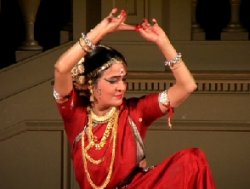 |
 |
Sristuti
July 9, 2004 The cultural committee of the Indian Association Zurich (IAZ) organised an evening of the Indian classical dance Odissi by Indian danseuse Kumkum Lal. The Association is a 50-year-old socio - cultural organisation and aims at preserving Indian culture on foreign soil. |
 |
| The program
was held at the Aula auditorium of the ETH University on Friday, 25th June
2004. The IAZ President, Mr. Arun Amirtham, introduced the artist Kumkum
Lal, welcomed the distinguished audience as well as the Chief Guest, Mr.
Praveen Lal Goyal, Indian Ambassador to Switzerland.
Kumkum Lal has spent most of her life amidst the ambience of Indian dances since her childhood. She learnt the styles of Manipuri, Kuchipudi and Bharatnatyam before pursuing to excel in Odissi dance. She has popularized the dance in Japan and still today continues to enchant and educate audiences in India and abroad. Dr.Minati Mishra, recipient of the President’s Sangeet Akademi Award, in a short presentation, dedicated the performance in memory of the late guru Kelucharan Mahapatra. She spoke on behalf of herself and also Kumkum Lal about their Guruji. Mahapatra, an exponent of Odissi dance, was a recipient of the prestigious Padma Vibhushan award. His deep influence on two of his students, as artists and as individuals, over a few decades of association was apparent. She explained that Odissi dance has evolved out of spiritual consciousness. All actions and styles of this dance originate in the temples of Orissa and are woven around the daily rituals. Kumkum Lal began her recital with piece called ‘Managalcharan’, a traditional prayer to mother Earth on whom we stamp upon and therefore ask for blessings. Thereafter she danced offering a prayer to Lord Ganesha, favourite son of Goddess Parvati and Lord Shiva and an excellent dancer himself. The dance was a vivid portrayal using graceful movements of the hand and body to describe the physical appearance of Ganesha. The audience could imagine him in his usual posture sitting under a tree, highlighting his trunk, fat paunch and eating sweets! The next dance
was called ‘Pallavi’. The audience got to see the different forms of art
that Odissi dance can be adapted to – be it a poem, a song, a story or
just mnemonics. To music based on pattern Raag Saveri, Kumkum Lal portrayed
a lover in her various moods of longing, waiting, beckoning and dressing
up for her beloved. The dance built a crescendo of dance, rhythm and melody
to bring forth the romanticism.
The fourth dance was called ‘Dashavatara’. Also an excerpt from the Jayadeva’s Geeta Govind, it described the ten forms or incarnations adopted by Lord Vishnu as he transcended upon Earth as the savior. The last dance was appropriately called ’Moksha’, which literally means liberation or nirvana. Kumkum Lal described Nirvana as the catharsis of an aesthetic experience where the human soul merges with that of God. The dancer started each piece with a brief explanation, which helped the audience to enjoy and absorb the theme of the dance as well. All the music pieces were composed by Guru Kelucharan Mahapatra. In the playback, the violin was played by Bhubaneshwar Mishra, Guruji himself played the drums, vocal artist was Pallavi Brahmachari and Partha Das played the Sitar. The DVD
of this program is available with Mr. Aditya Banerjee
Sharmi Banerjee is a member of the Indian Association Zurich. |